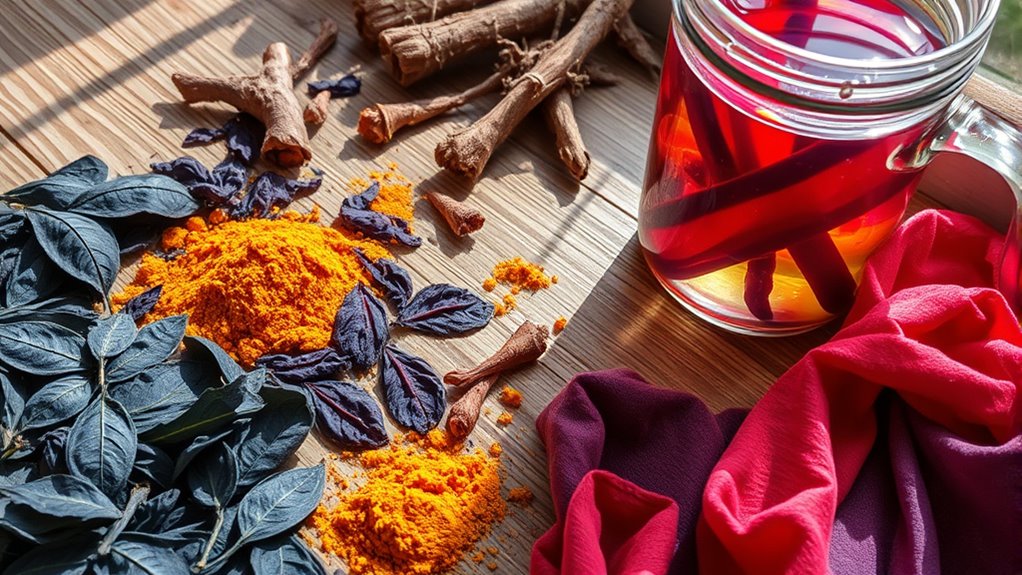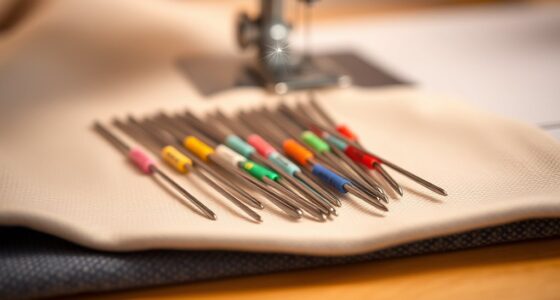To start DIY natural fabric dyeing at home, gather plant materials like beets, turmeric, or blackberries, then simmer them to extract vibrant color. Prepare your fabric with an eco-friendly mordant like alum or tannin to help lock in the hue. Immerse the fabric in the dye bath for about 30 minutes, then rinse and dry away from direct sunlight. If you want to explore more about creating beautiful, eco-friendly textiles, keep exploring these simple tips.
Key Takeaways
- Gather plant materials like beetroot, turmeric, or blackberries, then simmer and strain to create your natural dye liquid.
- Choose eco-friendly mordants such as alum or tannin extracts to fix the dye and enhance colorfastness.
- Fully immerse your fabric in the dye bath for 30 minutes to an hour, adjusting immersion time for desired shades.
- Rinse the dyed fabric in cold water until clear, then hang to dry away from direct sunlight.
- Layer multiple plant dyes and mordants for complex, unique colors, creating eco-friendly, beautiful textiles at home.

If you’re interested in adding unique, eco-friendly colors to your fabrics, DIY natural fabric dyeing is a simple and rewarding project. This method allows you to create vibrant, one-of-a-kind textiles using plant-based dyes and eco friendly mordants. Unlike commercial dyes, natural dyes come from plants, roots, berries, and even spices, making them a sustainable choice for your craft. You can transform plain fabrics into beautiful, eco-conscious pieces while reducing chemical waste and supporting environmentally friendly practices.
Discover the joy of eco-friendly, plant-based fabric dyeing for beautiful, sustainable textiles.
To get started, gather your plant-based dyes, which can include items like beetroot, turmeric, indigo, or blackberries. These natural sources provide rich colors that range from yellows and reds to blues and purples. When preparing your dyes, chop or crush the plant material and simmer it in water, extracting the pigment. Strain out the solids and keep the liquid, which will serve as your dye bath. The longer you simmer, the more concentrated the color will become. Keep in mind that natural dyes often produce softer, more muted shades compared to synthetic dyes, but they can be intensified with mordants or layered with other plant dyes. Additionally, understanding the properties of different materials can help you achieve desired effects and optimize dye uptake.
Using eco friendly mordants is essential to improve dye adherence and colorfastness while maintaining sustainability. Traditional mordants like alum or iron are effective, but you can also opt for plant-based mordants such as alum sourced from natural minerals or tannin-rich plant extracts like oak or chestnut. These eco-friendly mordants help fix the dye to your fabric without introducing toxic chemicals. Before dyeing, soak your fabric in a mordant solution, which allows the fiber to better absorb the plant dyes and results in more vibrant, long-lasting colors. Always follow proper safety precautions when handling mordants, even eco-friendly ones.
Once your fabric is mordanted and your dye bath is ready, submerge the fabric into the dye, ensuring it’s fully immersed. Keep the fabric in the dye bath for as long as needed to achieve your desired hue, often around 30 minutes to an hour. You can also experiment with varying immersion times or layering different plant dyes to create complex, nuanced shades. After dyeing, rinse your fabric in cold water until the water runs clear, then hang it to dry out of direct sunlight to preserve the color. This process not only results in beautiful, eco-conscious textiles but also allows you to enjoy the calming, meditative process of natural dyeing at home.
Frequently Asked Questions
How Long Does the Natural Dyeing Process Typically Take?
The dyeing time usually takes about 30 minutes to a few hours, depending on your desired color depth. During this process, your fabric absorbs the dye, and color development continues as it sits in the dye bath. Keep in mind that longer dyeing times generally result in richer, more vibrant colors. You can check periodically to see if the color has reached your preferred hue before removing the fabric.
Can Synthetic Fabrics Be Dyed Naturally?
Synthetic fabrics can be dyed naturally, but it’s often more challenging than dyeing natural fibers. You might find that synthetic fabrics don’t absorb natural dyes as well, resulting in less vibrant or uneven colors. Unlike natural fibers, which readily soak up plant-based dyes, synthetic fabrics resist these dyes, often requiring hot water, prolonged soaking, or mordants. So, while possible, dyeing synthetic fabrics naturally demands patience and experimentation.
Are Natural Dyes Colorfast and Washing Resistant?
Natural dyes can be quite colorfast and washing resistant when you use proper dye fixation and mordant techniques. By applying mordants like alum or iron before dyeing, you help the color bonds to the fabric more effectively. This process guarantees your dyed fabric retains its vibrant hue through multiple washes. Be sure to follow specific mordant instructions for each dye type to achieve the best colorfast results.
What Safety Precautions Should I Take During Dyeing?
You should wear protective gear like gloves and an apron to avoid staining your skin and clothes. Make sure good ventilation by working in a well-ventilated area or opening windows, especially when handling potentially irritating substances. Avoid inhaling fumes or dust, and wash your hands thoroughly after dyeing. Taking these safety precautions helps protect your health and keeps your workspace safe while you enjoy the dyeing process.
How Can I Achieve Consistent Color Results?
Achieving perfect, consistent color results might seem impossible, but you can conquer it! To minimize color variation and guarantee dye batch consistency, always measure your ingredients precisely and use the same fabric type and pre-treatment. Stir your dye bath thoroughly during each dip, and dye similar fabrics together. Keep detailed notes of your dyeing process so you can replicate successful results and avoid unpredictable color surprises every time!
Conclusion
Now that you’ve learned how to dye fabric naturally at home, remember that patience is key—like cultivating a garden, beautiful results take time. With a little effort and creativity, you can transform plain textiles into vibrant, eco-friendly masterpieces. Don’t be afraid to experiment and let your imagination run wild. After all, sometimes the most stunning colors come from the simplest ingredients—proving that beauty often blossoms from humble beginnings. Happy dyeing!









